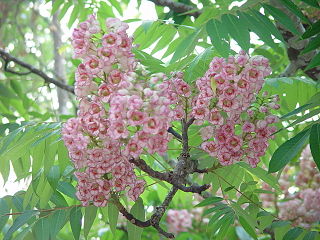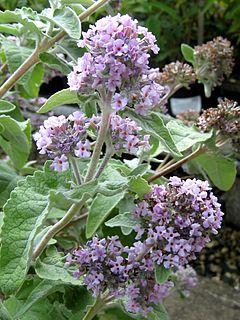
Buddleja is a genus comprising over 140 species of flowering plants endemic to Asia, Africa, and the Americas. The generic name bestowed by Linnaeus posthumously honoured the Reverend Adam Buddle (1662–1715), an English botanist and rector, at the suggestion of Dr. William Houstoun. Houstoun sent the first plants to become known to science as buddleja to England from the Caribbean about 15 years after Buddle's death.

Buddleja davidii, also called summer lilac, butterfly-bush, or orange eye, is a species of flowering plant in the family Scrophulariaceae, native to Sichuan and Hubei provinces in central China, and also Japan. It is widely used as an ornamental plant, and many named varieties are in cultivation. B. davidii is named after the French missionary and explorer in China, Father Armand David, who was the first European to report the shrub. It was found near Ichang by Dr Augustine Henry about 1887 and sent to St Petersburg. Another botanist-missionary in China, Jean-André Soulié, sent seed to the French nursery Vilmorin, and B. davidii entered commerce in the 1890s.

Cupressus torulosa, commonly known as the Himalayan cypress or Bhutan cypress, is a species of cypress tree native to South Asia.

Calocedrus formosana is a conifer endemic to Taiwan.

Calocedrus macrolepis is a conifer native to southwest China, northern Vietnam, northern Laos, extreme northern Thailand and northeastern Myanmar.
Zenia insignis is a species of legume in the family Fabaceae. It is a medium-sized tree, 15–20 metres (49–66 ft) tall. It is found in southern China and northern Vietnam. It is threatened by habitat loss and overharvesting. The species is under second-class national protection in China.

Amentotaxus argotaenia, the catkin yew, is a species of conifer in the family Taxaceae. It is a shrub or a small tree up to 7 metres (23 ft) tall.

Amentotaxus formosana, the Taiwan catkin yew, is a species of conifer in the family Taxaceae. It is a small tree to 10 m (33 ft) tall, with a slender trunk. It was previously recognised as a variant of Amentotaxus argotaenia.

Juniperus formosana, the Formosan juniper, is a species of conifer in the family Cupressaceae. It is a shrub or tree to 15 m (49 ft) tall, found in China and in Taiwan.
Juniperus komarovii is a species of conifer in the family Cupressaceae. It is found only in China.
Juniperus pingii is a species of conifer in the family Cupressaceae. Commonly used in bonsai, it can produce and correct proportional miniature version of the full size tree. It is native only to China.
Acalypha hontauyuensis is a species of plant in the family Euphorbiaceae. It is a shrub endemic to Orchid Island, Taiwan. The Flora of China, however, lists it as a synonym of Acalypha suirenbiensis from the Taiwanese mainland.
Acalypha suirenbiensis is a species of plant in the family Euphorbiaceae. It is endemic to Hualien County, Taiwan. The Flora of China, however, includes Acalypha hontauyuensis from Orchid Island in this species. It is a shrub growing about 3 m (10 ft) tall.

Bretschneidera sinensis, the sole species in genus Bretschneidera, is a rare, 10–20 metres (33–66 ft) tall tree with large inflorescences. It is found in south and east of China, Taiwan, northern Thailand and northern Vietnam. It is threatened by habitat loss. Because of its relatively recent discovery in Taiwan and Thailand, it is possible that it could also be found in Laos and northern Myanmar. It was named in honor of Emil Bretschneider.

Fagus hayatae, also known as Taiwan beech, is a species of beech tree. It can grow 20 metres (66 ft) tall. Taiwan Beech is the only beech of Taiwan. While IUCN reports it, though similar to Fagus lucida of China, as endemic to Taiwan, "Flora of China" and "Flora of Taiwan" also report it from China; "Flora of China" reports a wide but discontinuous mainland distribution between Sichuan in the southwest to Zhejiang in the east.

Helicia is a genus of 110 species of trees and shrubs, constituting part of the plant family Proteaceae. They grow naturally in rainforests throughout tropical South and Southeast Asia, including India, Sri Lanka, Indochina, Peninsular Malaysia to New Guinea and as far south as New South Wales.
Lithocarpus formosanus is a species of tree in the family Fagaceae. L. formosanus is a medium-sized tree with crooked trunk and many branches. It is endemic to Taiwan as it only occurs in the Hengchun Peninsula in the extreme south of the country. It grows in mixed mesophytic forests at altitudes of 100–500 m (330–1,640 ft). Only single population of fewer than 50 individuals survives.

Buddleja crispa, sometimes called the Himalayan butterfly bush, is native to Afghanistan, Bhutan, North India, Nepal, Pakistan and China, where it grows on dry river beds, slopes with boulders, exposed cliffs, and in thickets, at elevations of 1400–4300 m. Named by Bentham in 1835, B. crispa was introduced to cultivation in 1850, and came to be considered one of the more attractive species within the genus; it ranked 8th out of 57 species and cultivars in a public poll organized by the Center for Applied Nursery Research (CANR) at the University of Georgia, US.. In the UK, B. crispa was accorded the Royal Horticultural Society's Award of Merit in 1961. However, the species is not entirely cold-hardy, and thus its popularity is not as ubiquitous as it might otherwise be.

Cinnamomum osmophloeum, commonly known as pseudocinnamomum or indigenous cinnamon, is a medium-sized evergreen tree in the genus Cinnamomum. It is native to broad-leaved forests of central and northern Taiwan.
Buddleja curviflora is a deciduous shrub native to southern Japan and Taiwan, where it grows in thickets on stony slopes at elevations of 100–300 m. B. curviflora was named and described Hooker & Arnott in 1838. Plants in Taiwan have been described as a separate species Buddleja formosana and assessed as Critically Endangered by IUCN, but the distinction is not recognized by Li and Leeuwenberg, who sank formosana as a synonym.













